Global butadiene market is estimated to be valued at USD 37.61 Bn in 2025 and is expected to reach USD 57.72 Bn by 2032, exhibiting a compound annual growth rate (CAGR) of 6.3% from 2025 to 2032.
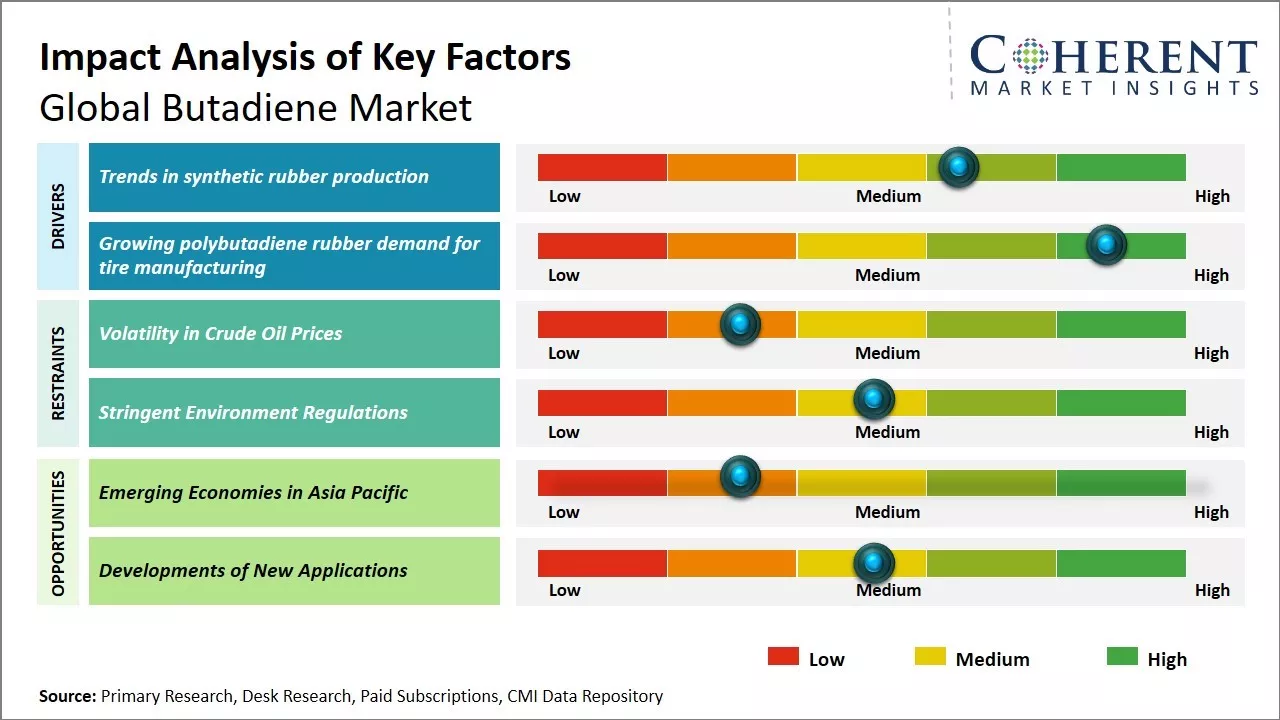
Discover market dynamics shaping the industry: Download Free Sample
Growing rubber industry is expected to boost demand for butadiene. Butadiene is a key raw material used in the production of synthetic rubber. Rise in the application of synthetic rubber in the automotive and tire industry can boost consumption of butadiene. Expanding production of automobiles around the world has increased demand for tires, and this has boosted demand for butadiene-based synthetic rubber. Growing infrastructure development activities contributes to the growth of the construction industry where synthetic rubber products find numerous applications. Thus, a thriving rubber industry backed by growth in automotive, tire and construction is expected to drive the global butadiene market growth in the near future.
Trends in synthetic rubber production
Global butadiene market growth is driven by growing synthetic rubber industry. Butadiene is used in the production of synthetic rubbers such as styrene-butadiene rubber and Polybutadiene rubber. These synthetic rubbers are increasingly used as substitutes for natural rubber in various applications due to benefits such as enhanced strength, flexibility and resistance properties. In the automotive industry, synthetic rubbers have gained widespread acceptance for use in tyres, hoses, belts, gaskets and other automotive components. The global automotive market has been growing consistently in recent years driven by rising vehicle ownership in emerging economies and demand for premium vehicles. As synthetic rubbers continue to find more applications in the automotive sector, their offtake of butadiene is expected to increase accordingly. Meanwhile, the construction industry is another major end user of synthetic rubbers for various purposes such as roofing sheets, pipes, seals and waterproofing systems. With rapid urbanization and infrastructure development projects worldwide, synthetic rubber consumption increases in the construction sector as well. The trends of replacing natural rubber with synthetic varieties extend to other industries including consumer goods, footwear and clothing. Advantages of synthetic rubbers over natural rubber such as affordability and consistent quality prompt industries to use materials like styrene-butadiene rubber.
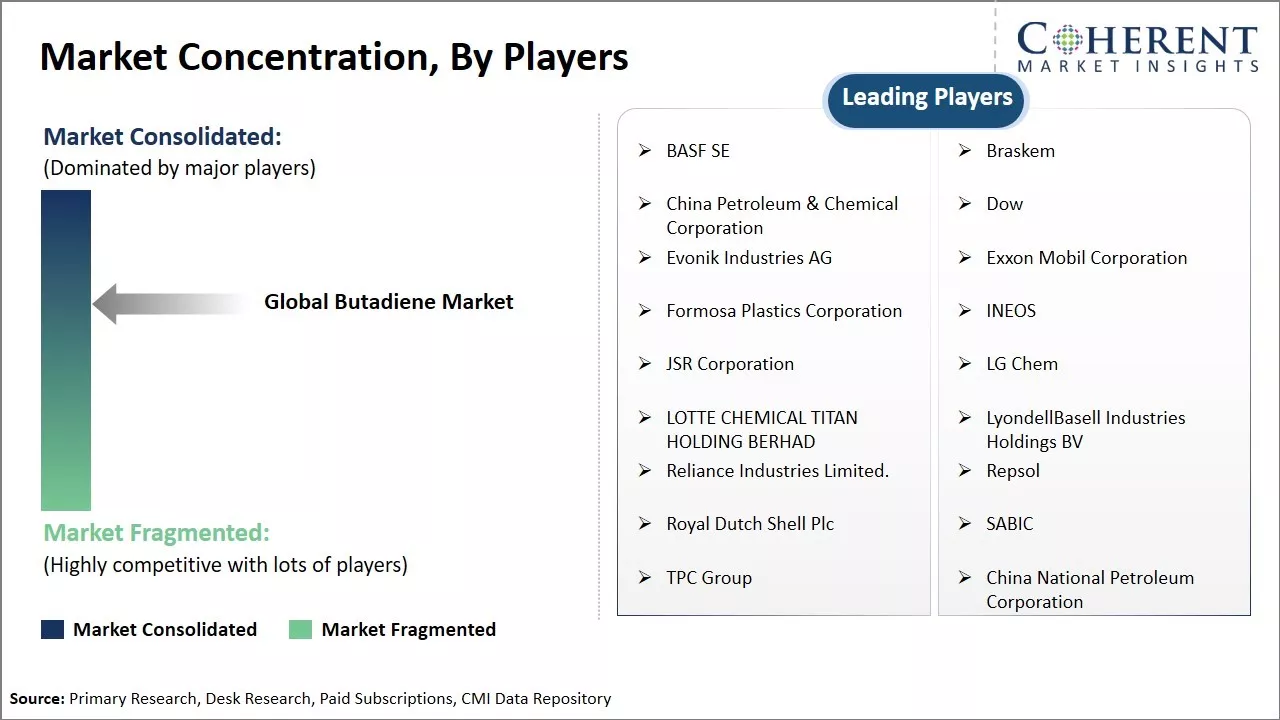
Get actionable strategies to beat competition: Download Free Sample
Growing polybutadiene rubber demand for tire manufacturingThe global butadiene market is experiencing significant growth due to rising demand for polybutadiene rubber in tire manufacturing applications. Polybutadiene rubber is a key raw material used in the production of tires as it provides strength, flexibility and wear resistance. Currently, over 60% of all polybutadiene rubber produced globally is consumed by the tire industry. As automobile production continues to increase steadily worldwide, tire demand is experiencing a parallel rise. For example, data from the International Organization of Motor Vehicle Manufacturers shows global automobile sales increased over 4% in 2021 from 2020 levels, reaching just under 79 million units. With more automobiles on the road, tire replacement rates are also rising which is further stimulating polybutadiene rubber consumption. This steady growth in the tire industry shows no signs of slowing in the coming years. Most forecasts predict automobile sales will grow at least 3-4% annually through 2025. Emerging economies like India and Indonesia are expected to see especially strong growth in vehicle ownership as personal income levels rise across larger segments of the population in these nations. As a result, demand for replacement tires in these developing auto markets will steadily support increased butadiene consumption for polybutadiene rubber production to meet this need. Other uses of butadiene in markets like plastics and latex are also expanding but at a more modest pace compared to its role as a base material for the resilient tire sector.
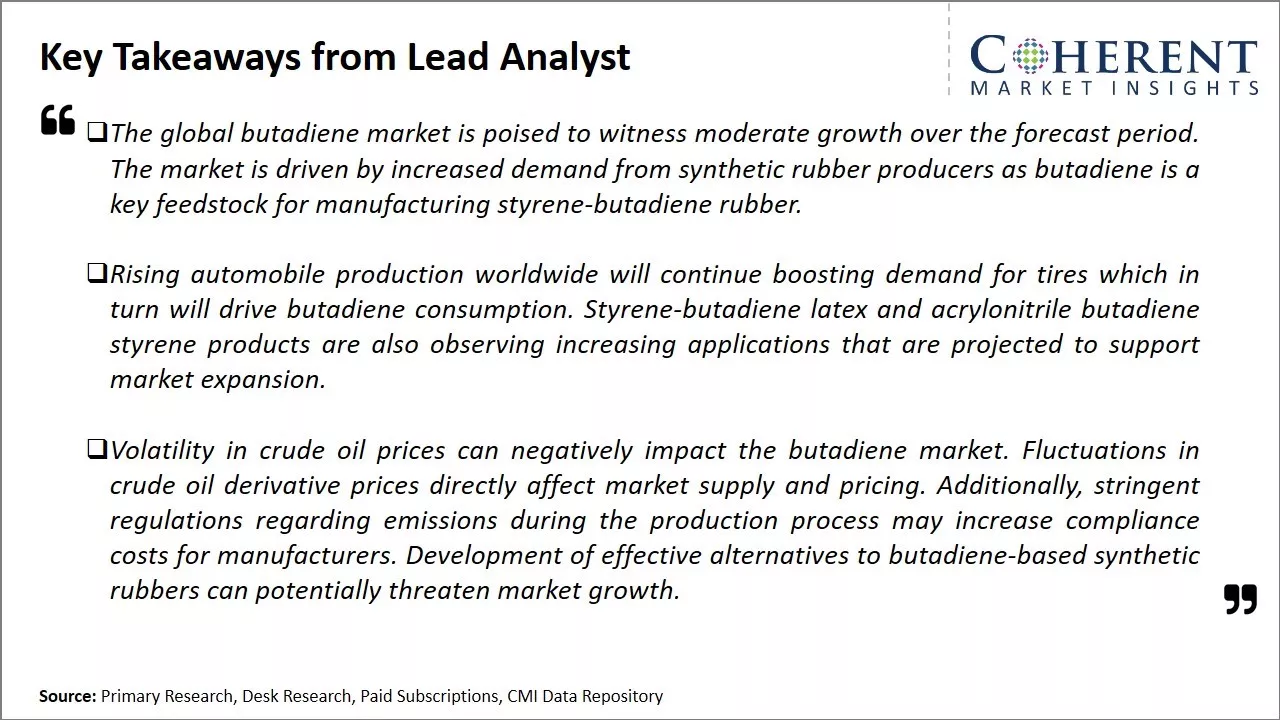
To learn more about this report, Download Free Sample
Challenge: Volatility in Crude Oil PricesGlobal butadiene market growth can be hampered due to the fluctuations in crude oil prices over the past few years. Butadiene is a fundamental petrochemical that is derived from naphtha feedstock obtained during the oil refining process. Around 90% of the global butadiene supply is sourced from steam cracking of naphtha and gas oil. Therefore, any variations in crude oil prices have a substantial impact on the production cost and supply availability of butadiene. With crude oil prices experiencing volatility due to geopolitical tensions, natural disasters and pandemic situation, producers of butadiene have faced major challenges in maintaining a stable supply chain. This volatility in the key raw material pricing has encouraged petrochemical companies to explore alternative butadiene production technologies that rely less on oil-based feedstock.
Opportunity: Emerging Economies in Asia Pacific
Emerging economies in the Asia Pacific region present a great opportunity for growth of global butadiene market. Countries like China, India, Indonesia and Vietnam are witnessing massive industrialization and infrastructure development, and this boosts demand for butadiene and downstream chemicals. Over the past decade, these nations have seen breakneck economic expansion with growth rates consistently higher than global averages. Rapid urbanization has led to the build-out of new cities, factories, highways and other construction projects.
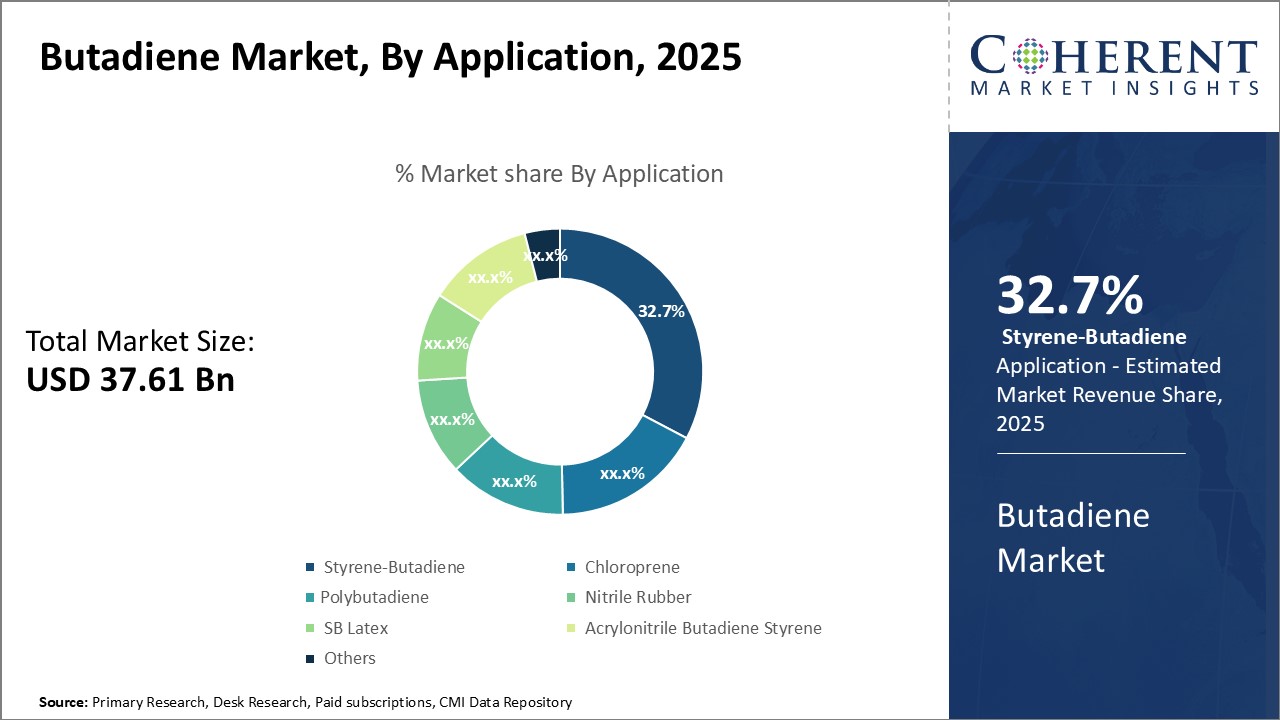
Discover high revenue pocket segments and roadmap to it: Download Free Sample
Insights, By Application: Styrene-Butadiene contributes the highest share of the market owning to its versatile propertiesAmong application, styrene-butadiene segment is estimated to hold 32.7% of the market share in 2025. Styrene-butadiene rubber, also known as SBR, is a versatile synthetic rubber that can be utilized in a wide range of applications. Its superior performance characteristics have made it a staple in many industries. SBR performs well in applications that require high abrasion resistance, good aging properties, and excellent handling capabilities. It maintains good tensile strength and tear resistance during processing and over its lifespan of use. The material provides excellent flexibility even at low temperatures, making it suitable for use in tires and rubber products meant for colder climates. The ease of processing SBR into different compound formulations has aided its popularity. Manufacturers can precisely tailor the ratio of styrene to butadiene monomers to achieve specific physical properties as required. This allows SBR to mimic the performance of natural rubber in many ways. However, it surpasses natural rubber in terms of cost-effectiveness, consistency, and resistance to degradation. Many industries rely on SBR for its ability to withstand dynamic stresses and strains. In the tire industry, SBR forms an integral part of the tread and sidewall compounds to deliver wear resistance, cut and chip resistances, and high traction capabilities.
Insights, By End-use Industry: Tire and Rubber industry dominance drives the End-Use market share of Butadiene
Among end-use industry, tire and rubber segment is estimated to hold 34.8% of the market share in 2025. The global tire and rubber industry has seen tremendous growth over the past due to rising vehicle ownership and demand for high-performance tires. With butadiene being a chief raw material in tire tread and sidewall compounds, its consumption in the tire segment has grown exponentially. Currently, over 60% of all butadiene produced globally is converted into high-quality rubbers utilized exclusively in the tire industry. Styrene butadiene rubber (SBR) synthesized using butadiene is the backbone of modern tire technology, accounting for over 30% of a typical passenger tire. Meanwhile, butadiene is also a key monomer in the production of polybutadiene rubber (PBR), another preferred formulation in high-performance tires, owing to its strength and resilience properties. PBR enables superior handling, traction and rolling resistance in passenger vehicle and truck/bus radial tires. Beyond tires, the rubber goods sector has also emerged as a sizable end-market for butadiene and its derivatives. Rubber molded and extruded products find applications as hoses, belts, footwear and various industrial goods where butadiene-based rubbers grant durability, flexibility and weather resistance.
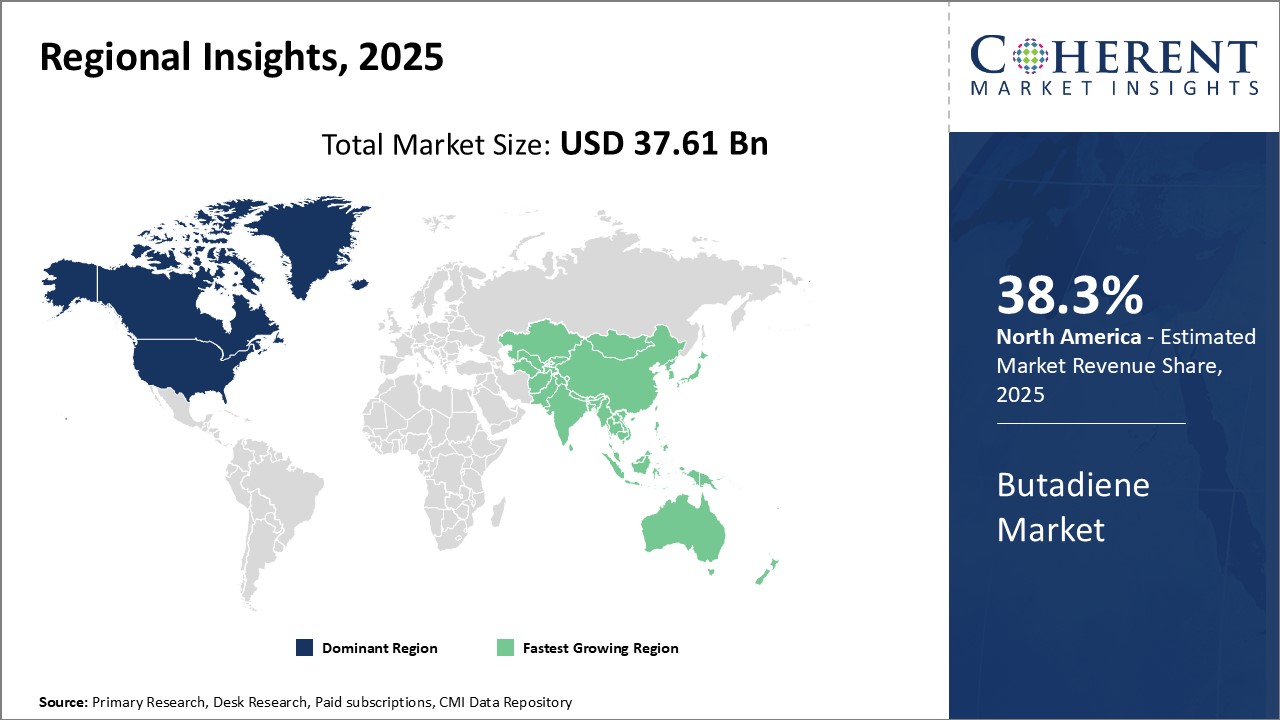
Need a Different Region or Segment? Download Free Sample
North America has established itself as the dominant player in the global butadiene market over the years with estimated 38.3% share in 2025. The region is home to some of the largest butadiene producers who have been operating in the sector for decades. Companies based in the U.S. and Canada have made massive investments in production facilities and R&D centers to develop innovative processes. North America accounts for the largest share of global butadiene production and exports a significant amount to other key markets. The strong presence of the automotive and construction industries has consistently driven butadiene demand upwards in North America. A large portion of the butadiene produced is utilized to make styrene-butadiene rubber, acrylonitrile-butadiene-styrene and nitrile rubber—materials that find widespread applications in tires, pipes, and various building components.
The Asia Pacific region has emerged as the new global hotspot for the butadiene industry over the past decade. Countries such as China, India, South Korea and Japan have experienced accelerated industrialization and rising consumption patterns. The expanding automotive, tire, and plastic consumer goods sectors in these developing Asian economies boosts butadiene demand.
Butadiene Market Report Coverage
| Report Coverage | Details | ||
|---|---|---|---|
| Base Year: | 2024 | Market Size in 2025: | USD 37.61 Bn |
| Historical Data for: | 2020 To 2024 | Forecast Period: | 2025 To 2032 |
| Forecast Period 2025 to 2032 CAGR: | 6.3% | 2032 Value Projection: | USD 57.72 Bn |
| Geographies covered: |
|
||
| Segments covered: |
|
||
| Companies covered: |
BASF SE, Braskem, China Petroleum & Chemical Corporation, Dow, Evonik Industries AG, Exxon Mobil Corporation, Formosa Plastics Corporation, INEOS, JSR Corporation, LG Chem, LOTTE CHEMICAL TITAN HOLDING BERHAD, LyondellBasell Industries Holdings BV, Reliance Industries Limited., Repsol, Royal Dutch Shell Plc, SABIC, TPC Group, China National Petroleum Corporation |
||
| Growth Drivers: |
|
||
| Restraints & Challenges: |
|
||
Uncover macros and micros vetted on 75+ parameters: Get instant access to report
Share
Share
About Author
Vidyesh Swar is a seasoned Consultant with a diverse background in market research and business consulting. With over 6 years of experience, Vidyesh has established a strong reputation for his proficiency in market estimations, supplier landscape analysis, and market share assessments for tailored research solution. Using his deep industry knowledge and analytical skills, he provides valuable insights and strategic recommendations, enabling clients to make informed decisions and navigate complex business landscapes.
Missing comfort of reading report in your local language? Find your preferred language :
Transform your Strategy with Exclusive Trending Reports :
Frequently Asked Questions
Joining thousands of companies around the world committed to making the Excellent Business Solutions.
View All Our Clients